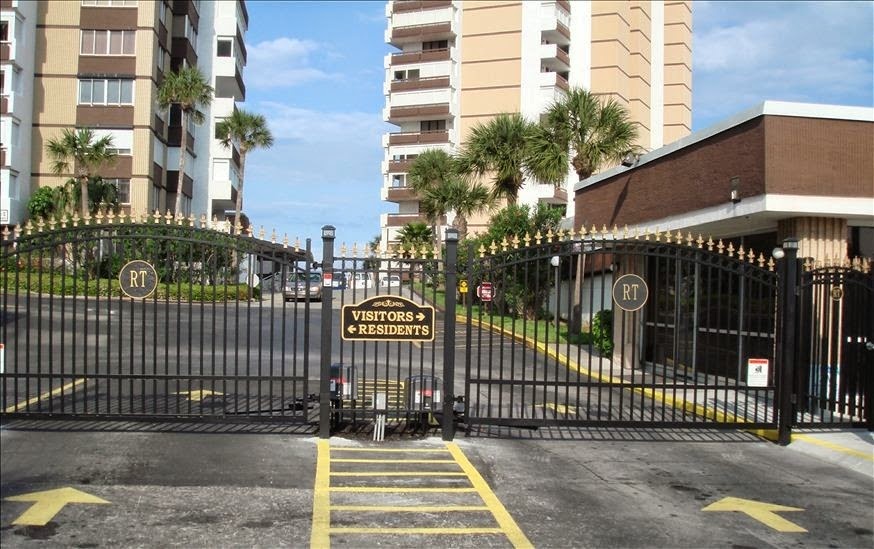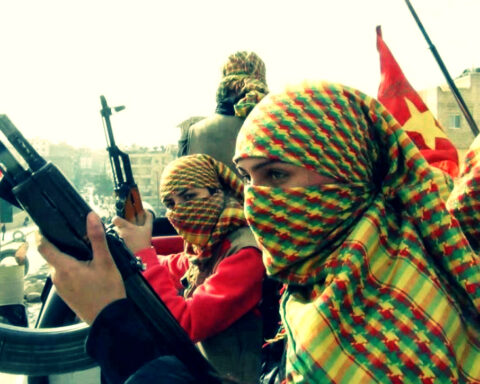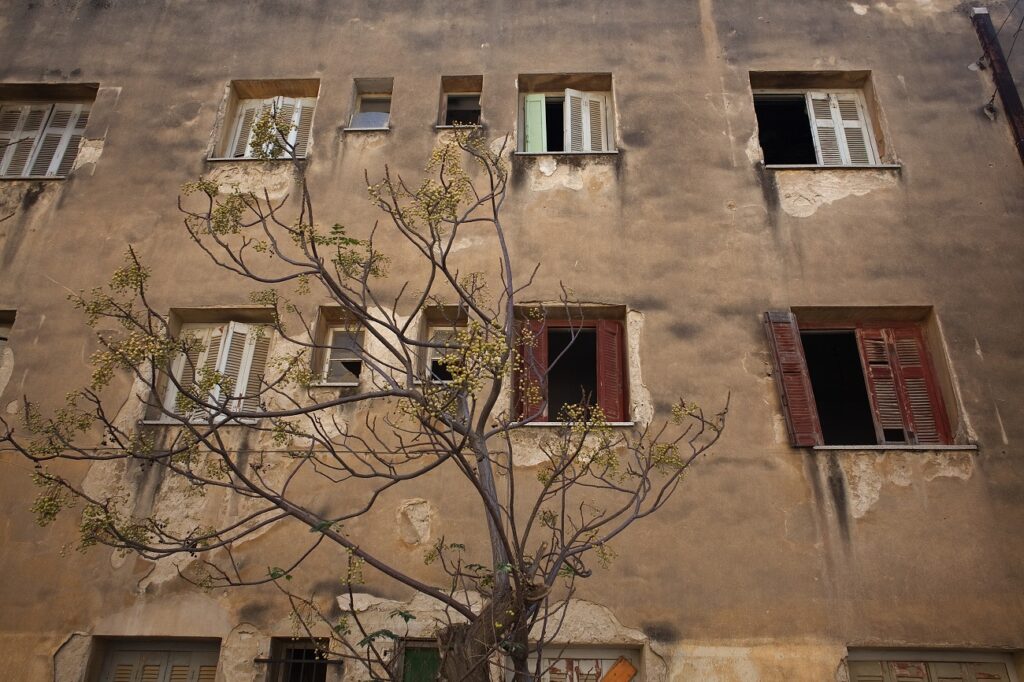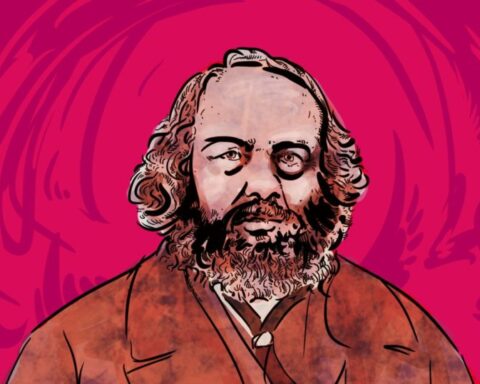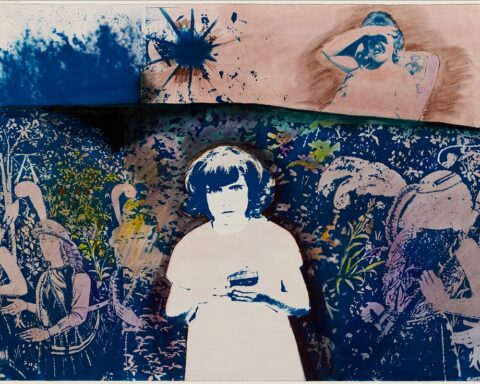Sociologist Zaire Zenit Dinzey-Flores discusses how the concentration of class and racial privilege in gated communities takes place alongside the spatial concentration and confinement of the poor. She argues that gates help sort and segregate people, physically and symbolically distinguish communities, and cement inequality.
“You drive to the gate. The community is in the shape of a U. You come in one gate and leave through the other. When you get to the gate, you will have a dial pad. You have to dial my number. Here is the number. Wait for me to answer. I will ask you who you are. You will tell me. Once you talk to me I will push the button to open the gate and let you in. The gate will open. You will be allowed in. You will drive to my house. I will be outside waiting for you.”
Following Ramiro’s careful directions, I entered Extensión Alhambra a subdivision of colorful, concrete, one and two-story single-family homes located in Ponce, Puerto Rico’s second largest city, in the southern part of the island. Extensión Alhambra which looks like a mid-century American suburb, was intended to be an exclusive community for middle- and upper-middle-income families, its name evoking Spain’s famous Moorish castle, the Alhambra. When it was built in the early 1970s, Extensión Alhambra was open to all. But in 1993 residents took advantage of a 1987 law (Ley de Cierre, or “closing law”) that permitted communities to build gates for protection. With that law, many previously open and private middle-class housing subdivisions were gated—part of the vast array of communities worldwide that form neighborhood associations, erecting fences and fortresses, and taking protection into their own hands.
Less than half a mile from Extensión Alhambra is a very different kind of gated community. Here, in a development called Dr. Manuel de la Pila, twenty low-rise multiple-dwelling buildings, totaling 906 units, comprise the largest public housing community in the city of Ponce. Dr. Manuel de la Pila is one of 337 public housing projects built in Puerto Rico as part of the massive post-war U.S. federal public housing push that by the second half of the twentieth century had furnished Puerto Rico with more public housing units than any U.S. city—after New York.
Like Extensión Alhambra, when it was first built Dr. Pila was an open community. But early one November morning in 1994, two years after a private firm had taken over its management, three helicopters carrying national guards and police descended upon the project, officially occupying it. Operation Centurion, popularly known as Mano Dura Contra el Crimen (Strong Arm Against Crime), had dictated that the largest, presumably most dangerous public housing projects should be gated in order to reduce crime. Over the course of four years, nearly a quarter of
Puerto Rico’s 337 public housing developments were “rescued” or “occupied,” leading to arrests of residents, the establishment of police outposts, and the erection of fences to control movement. Dr. Pila became a gated public housing development.
Gates and guards have typically been ways for privileged communities to “defend” themselves, creating secure residential environments. In their quest for security, gates symbolize “withdrawal [from the city]” and they also produce fear, according to
Teresa P. R. Caldeira, professor of city and regional planning at the University of California. Promising to protect residents from crime, as well as from fears of declining property values and loss of prestige and exclusivity, gated communities enable affluent residents to imagine that they can leave the unruly, dangerous spaces of cities behind.
The concentration of class and racial privilege in suburbs, fortressed enclaves, securitized buildings, and private islands takes place alongside the spatial concentration of poverty in ghettos, favelas, and barrios. Residential gates for the rich have also led to the rise of gates for the poor—in favelas in Brazil, South African townships, peripheral urban migrant settlements in China, and even in some public housing developments in the United States. The built environment sorts and segregates people, physically and symbolically distinguishing communities from one another. Whether one is locked inside or kept outside is determined by one’s race, class, and gender. In both kinds of gated communities, controlled access points restrict movement in and out. However, living in gated communities of the rich and poor are vastly different experiences.
The privileged gates of Extensión Alhambra offer a retreat into a secure, idyllic community; newly privatized street and sidewalks are restricted to sanctioned, paying community members, who can decide who is allowed inside. In the impoverished community of Dr. Pila, in contrast, government and private overseers control the movement of residents. So while the gates of Extensión Alhambra permit their affluent residents to exert greater political and social influence over their home turf, in Dr. Pila they have the opposite effect, diminishing residents’ power. In privileged communities, gates lock undesirables out; in poor communities, they lock them in. In both cases, gates are erected to serve the interest of the upper classes, who are primarily white. In other words, gates reproduce inequality, and cement or—to use Michel DeCerteau’s term—“politically freeze” social distinctions of race and class.
In And/Or Out
Ramiro greeted me warmly. To enter the well-appointed homes and interior gardens of Extensión Alhambra, where he lived, I had to find people who would vouch for me and arrange for me to gain entrance. Once inside the gate, I had to justify myself and answer their interrogations about who I knew, what I was doing, and why. I came to understand that the residents of Extensión Alhambra were suspicious or confused about me because of my brown skin, which contrasted with the light-skinned people depicted in the photographs sitting on Ramiro’s living room coffee table. According to the 2000 Census, most residents of these privileged communities racially identified as “Caucásico” (Caucasian) or “Blanco” (white)— “race symbols,” in the words of economist Glen Loury, which are enlisted to help navigate these newly privatized community spaces. Negotiations of membership and belonging occur; outsiders and insiders are sorted and profiled.
The residents of Dr. Pila know that they are the ones affluent Alhambra residents wish to keep out. “The controlled access in Extensión Alhambra allows people from that area to enter,” one woman explained. “They think people from public housing want to go there to rob them. For them, we are society’s scum.” Another Dr. Pila resident agreed: “When they put up that gate in Extensión Alhambra, it was so that the people from public housing would not go there, so that the vermin would not enter.” Residents of both private and public communities told me that a race credential was required for someone to enter community spaces. A resident of a nearby private upper-middle class community that had been unsuccessful in putting up gates said that her whiteness prevented her from entering Dr. Pila: “I would be in a panic,” she said, “because I feel different even physically [as a] a blonde woman!”
Gates separate adjacent neighborhoods, freezing race, class distinctions, and demarcating social distances; they segment identities and mark the “unmarked.” Gates position and remind specific bodies of their rightful place, delineating identities and neighborhood limits, and discouraging movement. They also remind people that public housing is dangerous. Together with media representations of crime, they reinforce the idea that dark young males, in particular, are unemployable, dangerous, and criminal.
Rafa, a dark-skinned, bored young man who lived in Dr. Pila, explained, “You go and ask if they have [any work] and they say they don’t. And then they give the job to the favorites.” Residents of public housing projects often spoke about being turned down for jobs, which they saw as related to their place of residence. Don Ramon, an employer at a job fair organized by the social workers in Dr. Pila, said he was there to offer job opportunities that were typically denied to residents of public housing. Dinora, a resident, described a job interview. When she got there, the supervisor asked her where she was from. “When I told him I was from Dr. Pila,” she said, “his attitude changed to ‘I’ll call you if anything comes up.’ He went from an attitude that the job was for-sure to an attitude, once I said where I lived, of ‘I’ll call you later.’”
The physical and symbolic meaning of the gates were obvious to public housing residents. As one woman told me: “By putting up our gate,” they’re not interested in “protect[ing] our community, or its residents.” What they are doing, she said, is “isolat[ing] public housing from wealthy people. They have no reason to think they’re better than us. We’re all people.” The gates cement physical separation. Public housing residents resent not being able to take their children to trick-or-treat during Halloween in the more privileged areas. Opportunities for engaged contact are practically nonexistent.
Getting Inside The Gates
Getting inside Extensión Alhambra takes careful planning. Ramiro’s screening interrogation gave him decisive control over my entry and presence in the public streets and sidewalks of the community, much like the power he and his neighbors wield to make decisions about who enters their private home spaces. With the Closing Law that allowed private communities to gate themselves in the interest of safety, security technology came to facilitate the control rich people exercise over private spaces. Private guards follow orders through telecoms or telephones; electronically-powered gates allow owners to exert control through remote beepers, security spikes and electric currents, administering entry and exit as they see fit. In private communities, residents and visitors are welcomed into safe havens protected from outside perils. Whether one is welcome depends on who is seeking entry, and who is doing the credentialing. This credentialing is done by residents; in public housing, in contrast, the government makes such decisions, seizing control from residents. The gate in Extensión Alhambra “is private,” a resident of Dr. Pila told me: “here it is controlled.” When a temporary fence was first built, residents of Dr. Pila thought their own gate would function similarly to that of Extensión Alhambra, with residents controlling entry either through remote access or granting approval to the guard. But in time, their ability to control entry diminished. Rather than work in the service of residents, a police sentry with a one-way mirror came to control residents, federally inspired zero-tolerance regulations demanded that residents be screened, and the government appointed social workers to organize community activities. Residents, not visitors, came under scrutiny. As one woman explained: “I have been stopped, and asked what building I am going to, what am I going to do. They see the face of a crook in me.”
To enter the gated caserío (public housing) was, as one resident said, to lose the capacity to “move freely,” and instead to be controlled, isolated, and actively barred from freedom of contact both inside and outside. Just as residents’ movements were restricted, so were mine. Upon entering Dr. Pila, visitors and residents are signaled to stay out or wait by a sign in front of the guardhouse that reads: “Residential zone with controlled access. Any resident or visitor without identification must identify himself at the entry. Visiting cars are subject to search. Housing Administration.” The sign is a reminder that entering public housing makes one suspect.
As they block access to outsiders and turn public spaces—the street, the sidewalks—into private community property, these gates expand the power of privileged insiders over urban space and development. The gates that lock some in and others out hand control over the city to the privileged, giving the poor little recourse, little control, and less and less power.
Cemented Distinctions
Puerto Rico illustrates the ways social inequalities are physically and symbolically articulated in residential urban built environments throughout the world, underscoring differences in power and agency. Throughout the world, security policies have become a popular way to address feelings of insecurity in urban areas. Gates in residential areas and public spaces, security guards, security cameras, and metal detectors sort and divide city residents. In China, for example, new urban migrants are being locked in enclaves in the city’s periphery. There, as in Latin America and the rest of the developing world, as well as in the United States, grave social inequalities are spatialized in residential neighborhoods, new technologies delimit insiders and outsiders, and the rich exert power over the poor.
Community gates signal and reconstitute deep social inequalities, both imagined and real. For the rich, the public is increasingly privatized; for the poor, the private sphere is increasingly subject to public surveillance. For both, social activities are limited to the family unit and to intimate and exclusive spaces. Those who can afford to do so “bowl alone” and live alone. Those of lesser means are subjected to monitoring, control, and surveillance in their places of residence. This bunker mentality diminishes the spontaneity of public life.
Although the gates of Puerto Rico’s public housing are not in operation today, the fences are still there. The police no longer patrol the grounds, and only a boarded-up guardhouse remains. Entry and exit is no longer formally monitored, but the remains of the public gates continue to interfere with everyday routines, segregating and re-inscribing social inequality. Meanwhile, the gates around the private enclaves continue to be fortified by technology. The gates of the poor and the rich face each other, turning residents away from the city and its salutary social promises.
Recommended Resources
Atkinson, Rowland and Sarah Blandy. Gated Communities: International Perspectives (Routledge, 2006). Provides a wide array of gated community case studies.
Blakely, Edward J. and Mary Gayle Snyder. Fortress America: Gated Communities in the United States (Brookings Institution Press, 1999). The first book-length work on gated communities, it provides an account of how gated communities emerged in the United States.
Caldeira, Theresa P. R. City of Walls: Crime, Segregation, and Citizenship in São Paulo (University of California Press, 2000). Examines gated communities and their relationship to crime and class segregation in Brazil.
Costa Vargas, João. “When a Favela Dared to Become a Gated Condominium: The Politics of Race and Urban Space in Rio de Janeiro,” Latin American Perspectives (2006), 33(4): 49–81. One of the few examinations of gates in poor communities, it explores the relationship of gates to urban poverty and race in Brazil.
Low, Setha. Behind the Gates: Life, Security, and the Pursuit of Happiness in Fortress America (Routledge, 2003). Provides a historical background of gated communities and uses ethnography to see how privilege is contained behind gates.
Safa, Helen I. The Urban Poor of Puerto Rico: A Study in Development and Inequality (Rinehart and Winston, 1974). The first and only book-length study examining life in Puerto Rico’s public housing.
>>>
Zaire Zenit Dinzey-Flores is in the sociology and Latino & Hispanic Caribbean studies departments at Rutgers University. She is the author of Locked In, Locked Out: Gated Communities in a Puerto Rican City, from which this article was adapted.
source: American Sociological Association
http://contexts.org/articles/fall-2013/gated-communities-for-the-rich-and-the-poor/
